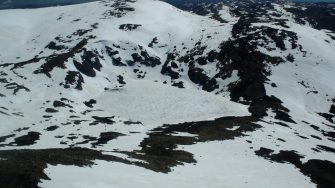
Date: Tuesday, October 26, 2021
Project: Eastern Australian Waterbird Survey
Observers: Richard Kingsford & John Porter
Pilot: James Barkell
We headed south out of Sydney, down the coast straight towards Bermagui on the south coast of New South Wales. That's where our survey band 2 started on its eastern end. We started by surveying Wallaga Lake, with a few swans, egrets and pelicans.
There were also a few black swans nesting on the freshwater swamps around here. We try and record as many breeding birds as possible during these aerial surveys. Mostly these are swans, ibis, cormorants and herons but occasionally we will see a brood of ducks. It is another important index that we can track over time on the state of waterbird populations in a particular year. This year lots of swans have been breeding which is a good sign, probably indicative of widespread breeding of many species.
We also surveyed about six estuaries down along the 30km wide survey band, down here in the south. Most of these just had a handful of pied and great cormorants and a few herons.
Each survey of a wetland requires quite a bit to be done before we get there, what we survey and information about the wetland. This includes guiding the pilot to the wetland and the particular angle to fly in and survey. Then the person in the front also needs to think about the path coming out of the wetland and where to next. Each wetland has a number which needs to be given onto the tape recorder and then the waterbirds obviously need to be counted over the wetland. There is also an assessment of how full the wetland is.
From here, we headed across the Great Dividing Range to the Monaro Plains near Cooma. This area is peppered with small natural Lagoons which are mostly dry. But today many of them had held water, although not all full as they have been in some years.
From here, we went on to survey Jindabyne Dam, which only had a few silver gulls, even though this is a huge expanse of water, before heading up over the Snowy Mountains.
Flying over the frozen Blue Lake in Kosciuszko National Park, a wetland of international importance under the Ramsar Convention.
From here, once we had crossed the mountains, we surveyed Dartmouth Dam, the massive dam on Mitta Mitta River at the head of the River Murray. Like all these large dams, but this one in particular, there was not a single waterbird despite so much water. Not even a cormorant or pelican. No waterbirds means only one thing – no food for waterbirds. The dam is just too deep.
Surveying Dartmouth Dam.
We then headed down the Mitta Mitta River where there were a few ibis and wood ducks, before landing in Albury to refuel.
Surveying the Mitta Mitta River.
After lunch, we headed south to survey Band 1, south and east of Melbourne. Its most easterly point is at Seaspray, just south of the Gippsland Lakes.
Flying over the Gippsland Lakes on our way south to Survey Band 1
It was clear that, for the first time in many years, there was lots of water in the wetlands, including one of our key wetlands, Jack Smith Lake. And there were lots of shelduck and black swans. Many of swans had broods. There was also more than a hundred grey and chestnut teal.
From here, we went west, surveying a few farm dams and large dams all the way across to Phillip Island.
Surveying wetlands on Phillip Island was quite a surprise with so many Cape Barren geese. A few even had broods. There were also lots of breeding swans on the island.
Rhyll Swamp, near the town of Rhyll, often has breeding ibis and today there were a few hundred breeding white ibis and some cormorants.
Then we headed over the Otway Ranges, diving into a few of the large government built storages where there were very few waterbirds, just some cormorants. From here, we headed further west across the dams south of Colac and all the way to Curdies Inlet on the coast near Peterborough.
It was then a flight over the over the natural lagoons between here and Warrnambool. It had obviously been quite a wet year, with many of the lagoons full and quite a few black swans with broods, black duck and shelduck.
Lagoons east of Warrnambool.
We finished up flying down the Hopkins River into Warrnambool where we stayed overnight.
By Richard Kingsford.
